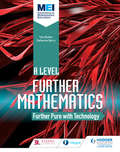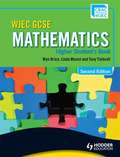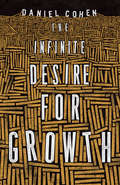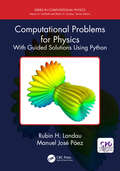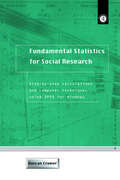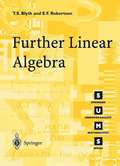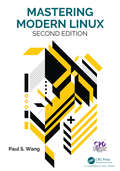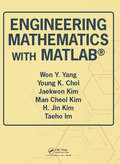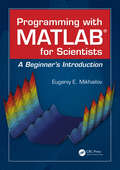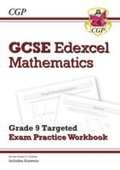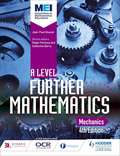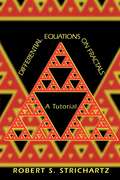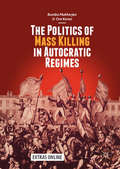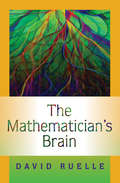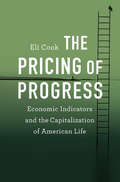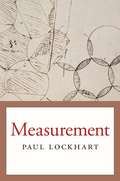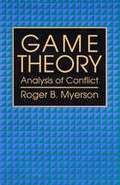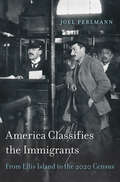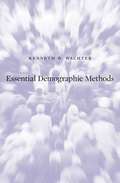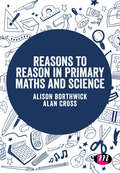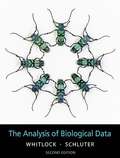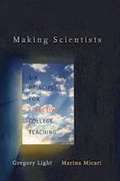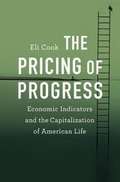- Table View
- List View
MEI Further Maths: Further Pure Maths with Technology (Mei a Level Further Maths) (PDF)
by Tom ButtonDevelop a deeper understanding of mathematical concepts and their applications with new and updated editions from our bestselling series. - Build connections between topics using real-world contexts that develop mathematical modelling skills, thus providing your students with a fuller and more coherent understanding of mathematical concepts. - Develop fluency in problem-solving, proof and modelling with plenty of questions and well-structured exercises. - Overcome misconceptions and develop mathematical insight with annotated worked examples. - Enhance understanding and map your progress with graduated exercises that support you at every stage of your learning.
WJEC GCSE Mathematics - Higher Student's Book (PDF)
by Wyn Brice Linda Mason Tony TimbrellThis Student's Book provides ideal preparation for the new 2010 WJEC GCSE in Mathematics specification at the Higher tier. It offers comprehensive guidance and practice for tackling problem-solving questions and the functional elements of mathematics - how maths is applied in everyday life. Fully supported by a Teacher's Resource and Homework Book, learners are encouraged to develop confidence in, and a positive attitude towards, mathematics. - Endorsed by WJEC for use with GCSE in Mathematics. - Complete coverage of all Units (1, 2, and 3) is provided through questions that increase in difficulty across the chapters and related revision activities. - Learning objectives and summaries for each chapter are written in a student-friendly style. - Exam tips help learners to focus on key areas for their revision, and open-ended challenges stretch students' skills and knowledge. - The same author team delivered Hodder's successful resources for the current WJEC Mathematics specification. The writers include current Chair of Examiners for GCSE Mathematics and current Chief Examiner of the two-tier Foundation Level specification. Their extensive teaching experience includes Head of Mathematics in schools in Wales as well as Senior Education Advisor roles. The series includes dedicated Student Books, Homework Books, and Teacher's Resources for both tiers.
The Infinite Desire for Growth
by Daniel Cohen Jane ToddWhy society’s expectation of economic growth is no longer realisticEconomic growth--and the hope of better things to come—is the religion of the modern world. Yet its prospects have become bleak, with crashes following booms in an endless cycle. In the United States, eighty percent of the population has seen no increase in purchasing power over the last thirty years and the situation is not much better elsewhere. The Infinite Desire for Growth spotlights the obsession with wanting more, and the global tensions that have arisen as a result. Amid finite resources, increasing populations, environmental degradation, and political unrest, the quest for new social and individual goals has never been so critical.Leading economist Daniel Cohen provides a whirlwind tour of the history of economic growth, from the early days of civilization to modern times, underscoring what is so unsettling today. The new digital economy is establishing a "zero-cost" production model, inexpensive software is taking over basic tasks, and years of exploiting the natural world have begun to backfire with deadly consequences. Working hard no longer guarantees social inclusion or income. Drawing on economics, anthropology, and psychology, and thinkers ranging from Rousseau to Keynes and Easterlin, Cohen examines how a future less dependent on material gain might be considered and, how, in a culture of competition, individual desires might be better attuned to the greater needs of society.At a time when wanting what we haven't got has become an obsession, The Infinite Desire for Growth explores the ways we might reinvent, for the twenty-first century, the old ideal of social progress.
The Infinite Desire for Growth
by Daniel Cohen Jane ToddWhy society’s expectation of economic growth is no longer realisticEconomic growth--and the hope of better things to come—is the religion of the modern world. Yet its prospects have become bleak, with crashes following booms in an endless cycle. In the United States, eighty percent of the population has seen no increase in purchasing power over the last thirty years and the situation is not much better elsewhere. The Infinite Desire for Growth spotlights the obsession with wanting more, and the global tensions that have arisen as a result. Amid finite resources, increasing populations, environmental degradation, and political unrest, the quest for new social and individual goals has never been so critical.Leading economist Daniel Cohen provides a whirlwind tour of the history of economic growth, from the early days of civilization to modern times, underscoring what is so unsettling today. The new digital economy is establishing a "zero-cost" production model, inexpensive software is taking over basic tasks, and years of exploiting the natural world have begun to backfire with deadly consequences. Working hard no longer guarantees social inclusion or income. Drawing on economics, anthropology, and psychology, and thinkers ranging from Rousseau to Keynes and Easterlin, Cohen examines how a future less dependent on material gain might be considered and, how, in a culture of competition, individual desires might be better attuned to the greater needs of society.At a time when wanting what we haven't got has become an obsession, The Infinite Desire for Growth explores the ways we might reinvent, for the twenty-first century, the old ideal of social progress.
Computational Problems for Physics: With Guided Solutions Using Python (Series in Computational Physics)
by Rubin H. Landau Manuel José PáezOur future scientists and professionals must be conversant in computational techniques. In order to facilitate integration of computer methods into existing physics courses, this textbook offers a large number of worked examples and problems with fully guided solutions in Python as well as other languages (Mathematica, Java, C, Fortran, and Maple). It’s also intended as a self-study guide for learning how to use computer methods in physics. The authors include an introductory chapter on numerical tools and indication of computational and physics difficulty level for each problem. Readers also benefit from the following features: • Detailed explanations and solutions in various coding languages. • Problems are ranked based on computational and physics difficulty. • Basics of numerical methods covered in an introductory chapter. • Programming guidance via flowcharts and pseudocode. Rubin Landau is a Distinguished Professor Emeritus in the Department of Physics at Oregon State University in Corvallis and a Fellow of the American Physical Society (Division of Computational Physics). Manuel Jose Paez-Mejia is a Professor of Physics at Universidad de Antioquia in Medellín, Colombia.
Fundamental Statistics for Social Research: Step-by-Step Calculations and Computer Techniques Using SPSS for Windows
by Duncan CramerThis accessible introduction to statistics using the program SPSS for Windows explains when to apply and how to calculate and interpret a wide range of statistical procedures commonly used in the social sciences. Keeping statistical symbols and formulae to a minimum and using simple examples, this book:* assumes no prior knowledge of statistics or computing* includes a concise introduction to the program SPSS for Windows* describes a wider range of tests than other introductory texts* contains a comprehensive range of exercises with answersFundamental Statistics for Social Research covers SPSS Release 6 for Windows 3.1 and Release 7 for Windows 95. It will prove an invaluable introductory statistics text for students, and a useful resource for graduates and professionals engaged in research in the social sciences.
Further Linear Algebra (Springer Undergraduate Mathematics Ser.)
by T. S. Blyth E. F. RobertsonFurther Linear Algebra is a natural sequel to the authors' highly acclaimed SUMS volume "Basic Linear Algebra". The more advanced topics covered here take the reader to the very heart of the subject, and include inner product spaces, direct sums of subspaces, the primary decomposition theorem and various canonical forms for matrices. Furthermore, the authors provide a brief introduction to the use of MAPLE in linear algebra calculations, and biographical profiles of eminent mathematicians associated with the subject.An introductory chapter recaps the prerequisites (for those readers unfamiliar with the first volume), and a wide range of worked examples and exercises (with solutions) are strategically placed throughout the text to consolidate understanding.
Mastering Modern Linux, Second Edition
by Paul S. WangPraise for the First Edition: "This outstanding book … gives the reader robust concepts and implementable knowledge of this environment. Graphical user interface (GUI)-based users and developers do not get short shrift, despite the command-line interface’s (CLI) full-power treatment. … Every programmer should read the introduction’s Unix/Linux philosophy section. … This authoritative and exceptionally well-constructed book has my highest recommendation. It will repay careful and recursive study." --Computing Reviews, August 2011 Mastering Modern Linux, Second Edition retains much of the good material from the previous edition, with extensive updates and new topics added. The book provides a comprehensive and up-to-date guide to Linux concepts, usage, and programming. The text helps the reader master Linux with a well-selected set of topics, and encourages hands-on practice. The first part of the textbook covers interactive use of Linux via the Graphical User Interface (GUI) and the Command-Line Interface (CLI), including comprehensive treatment of the Gnome desktop and the Bash Shell. Using different apps, commands and filters, building pipelines, and matching patterns with regular expressions are major focuses. Next comes Bash scripting, file system structure, organization, and usage. The following chapters present networking, the Internet and the Web, data encryption, basic system admin, as well as Web hosting. The Linux Apache MySQL/MariaDB PHP (LAMP) Web hosting combination is also presented in depth. In the last part of the book, attention is turned to C-level programming. Topics covered include the C compiler, preprocessor, debugger, I/O, file manipulation, process control, inter-process communication, and networking. The book includes many examples and complete programs ready to download and run. A summary and exercises of varying degrees of difficulty can be found at the end of each chapter. A companion website (http://mml.sofpower.com) provides appendices, information updates, an example code package, and other resources for instructors, as well as students.
Engineering Mathematics with MATLAB
by Won Y. Yang Young K. Choi Jaekwon Kim Man Cheol Kim H. Jin Kim Taeho ImThe aim of this book is to help the readers understand the concepts, techniques, terminologies, and equations appearing in the existing books on engineering mathematics using MATLAB. Using MATLAB for computation would be otherwise time consuming, tedious and error-prone. The readers are recommended to have some basic knowledge of MATLAB.
Programming with MATLAB for Scientists: A Beginner’s Introduction
by Eugeniy E. MikhailovThis book offers an introduction to the basics of MATLAB programming to scientists and engineers. The author leads with engaging examples to build a working knowledge, specifically geared to those with science and engineering backgrounds. The reader is empowered to model and simulate real systems, as well as present and analyze everyday data sets. In order to achieve those goals, the contents bypass excessive "under the hood" details, and instead gets right down to the essential, practical foundations for successful programming and modeling. Readers will benefit from the following features: Teaches programming to scientists and engineers using a problem-based approach, leading with illustrative and interesting examples. Emphasizes a hands-on approach, with "must know" information and minimal technical details. Utilizes examples from science and engineering to showcase the application of learned concepts on real problems. Showcases modeling of real systems, gradually advancing from simpler to more challenging problems. Highlights the practical uses of data processing and analysis in everyday life.
New GCSE Maths Edexcel Grade 8-9 Targeted Exam Practice Workbook (includes Answers) (PDF): EDEXCEL
by Cgp Books"This brand new CGP book is perfect if you’re aiming for the top grades in Higher Level Edexcel GCSE Maths! It’s packed with realistic exam-style questions covering only the most difficult topics - if you can get full marks here, you’ll be well on course for the top grade in the real exams. Step-by-step solutions (with a full mark scheme) are included. For even more help with GCSE Maths, don’t forget CGP’s matching Revision Guide (9781782944041) and Workbook (9781782944072). "
MEI A Level Further Mathematics Mechanics 4th Edition (PDF)
by Jean-Paul MuscatExam Board: MEI Level: A-level Subject: Mathematics First Teaching: September 2017 First Exam: June 2018 An OCR endorsed textbook Help students to develop their knowledge and apply their reasoning to mathematical problems with textbooks that draw on the well-known MEI (Mathematics in Education and Industry) series, updated and tailored to the 2017 OCR (MEI) specification and developed by subject experts and MEI. - Ensure targeted development of reasoning and problem-solving skills with plenty of practice questions and structured exercises that build mathematical skills and techniques. - Build connections between topics, using real-world contexts to help develop mathematical modelling skills, thus providing a fuller and more coherent understanding of mathematical concepts. - Help students to overcome misconceptions and develop insight into problem solving with annotated worked examples. - Develop understanding and measure progress with graduated exercises that support students at every stage of their learning. - Provide clear paths of progression that combine pure and applied maths into a coherent whole.
Differential Equations on Fractals: A Tutorial
by Robert StrichartzDifferential Equations on Fractals opens the door to understanding the recently developed area of analysis on fractals, focusing on the construction of a Laplacian on the Sierpinski gasket and related fractals. Written in a lively and informal style, with lots of intriguing exercises on all levels of difficulty, the book is accessible to advanced undergraduates, graduate students, and mathematicians who seek an understanding of analysis on fractals. Robert Strichartz takes the reader to the frontiers of research, starting with carefully motivated examples and constructions. One of the great accomplishments of geometric analysis in the nineteenth and twentieth centuries was the development of the theory of Laplacians on smooth manifolds. But what happens when the underlying space is rough? Fractals provide models of rough spaces that nevertheless have a strong structure, specifically self-similarity. Exploiting this structure, researchers in probability theory in the 1980s were able to prove the existence of Brownian motion, and therefore of a Laplacian, on certain fractals. An explicit analytic construction was provided in 1989 by Jun Kigami. Differential Equations on Fractals explains Kigami's construction, shows why it is natural and important, and unfolds many of the interesting consequences that have recently been discovered. This book can be used as a self-study guide for students interested in fractal analysis, or as a textbook for a special topics course.
The Politics of Mass Killing in Autocratic Regimes
by Bumba Mukherjee Ore KorenThis book develops a detailed, disaggregated theoretical and empirical framework that explains variations in mass killing by authoritarian regimes globally, with a specific focus on Pakistan, Indonesia, and Malaysia. Using a combination of game-theoretic, statistical, and qualitative approaches, this project explicates when civilians within nondemocratic states will mobilize against the ruling elite, and when such mobilization will result in mass killing. In doing so, it illustrates the important role urbanization and food insecurity historically played, and will continue to play, in generating extreme forms of civilian victimization.
The Mathematician's Brain: A Personal Tour Through the Essentials of Mathematics and Some of the Great Minds Behind Them
by David RuelleThe Mathematician's Brain poses a provocative question about the world's most brilliant yet eccentric mathematical minds: were they brilliant because of their eccentricities or in spite of them? In this thought-provoking and entertaining book, David Ruelle, the well-known mathematical physicist who helped create chaos theory, gives us a rare insider's account of the celebrated mathematicians he has known-their quirks, oddities, personal tragedies, bad behavior, descents into madness, tragic ends, and the sublime, inexpressible beauty of their most breathtaking mathematical discoveries. Consider the case of British mathematician Alan Turing. Credited with cracking the German Enigma code during World War II and conceiving of the modern computer, he was convicted of "gross indecency" for a homosexual affair and died in 1954 after eating a cyanide-laced apple--his death was ruled a suicide, though rumors of assassination still linger. Ruelle holds nothing back in his revealing and deeply personal reflections on Turing and other fellow mathematicians, including Alexander Grothendieck, René Thom, Bernhard Riemann, and Felix Klein. But this book is more than a mathematical tell-all. Each chapter examines an important mathematical idea and the visionary minds behind it. Ruelle meaningfully explores the philosophical issues raised by each, offering insights into the truly unique and creative ways mathematicians think and showing how the mathematical setting is most favorable for asking philosophical questions about meaning, beauty, and the nature of reality. The Mathematician's Brain takes you inside the world--and heads--of mathematicians. It's a journey you won't soon forget.
The Pricing of Progress: Economic Indicators and the Capitalization of American Life
by Eli CookHow did Americans come to quantify their society’s well-being in units of money? In our GDP-run world, prices are the measure of not only goods and commodities but our environment, communities, nation, even self-worth. Eli Cook shows how, and why, we moderns lost sight of earlier social and moral metrics that did not put a price on everyday life.
Measurement
by Paul LockhartLockhart’s Mathematician’s Lament outlined how we introduce math to students in the wrong way. Measurement explains how math should be done. With plain English and pictures, he makes complex ideas about shape and motion intuitive and graspable, and offers a solution to math phobia by introducing us to math as an artful way of thinking and living.
Game Theory: Analysis Of Conflict
by Roger B. MyersonEminently suited to classroom use as well as individual study, Roger Myerson's introductory text provides a clear and thorough examination of the models, solution concepts, results, and methodological principles of noncooperative and cooperative game theory. Myerson introduces, clarifies, and synthesizes the extraordinary advances made in the subject over the past fifteen years, presents an overview of decision theory, and comprehensively reviews the development of the fundamental models: games in extensive form and strategic form, and Bayesian games with incomplete information.
America Classifies the Immigrants: From Ellis Island to the 2020 Census
by Joel Perlmann PerlmannWhen more than twenty million immigrants arrived in the United States between 1880 and 1920, the government attempted to classify them according to prevailing ideas about race and nationality. But this proved hard to do. Ideas about racial or national difference were slippery, contested, and yet consequential—were “Hebrews” a “race,” a “religion,” or a “people”? As Joel Perlmann shows, a self-appointed pair of officials created the government’s 1897 List of Races and Peoples, which shaped exclusionary immigration laws, the wording of the U.S. Census, and federal studies that informed social policy. Its categories served to maintain old divisions and establish new ones. Across the five decades ending in the 1920s, American immigration policy built increasingly upon the belief that some groups of immigrants were desirable, others not. Perlmann traces how the debates over this policy institutionalized race distinctions—between whites and nonwhites, but also among whites—in immigration laws that lasted four decades. Despite a gradual shift among social scientists from “race” to “ethnic group” after the 1920s, the diffusion of this key concept among government officials and the public remained limited until the end of the 1960s. Taking up dramatic changes to racial and ethnic classification since then, America Classifies the Immigrants concentrates on three crucial reforms to the American Census: the introduction of Hispanic origin and ancestry (1980), the recognition of mixed racial origins (2000), and a rethinking of the connections between race and ethnic group (proposed for 2020).
One Quarter of Humanity: Malthusian Mythology And Chinese Realities, 1700-2000
by James Z. Lee Wang. FengOne Quarter of Humanity presents evidence about historical and contemporary Chinese population behavior that overturns much of the received wisdom about the differences between China and the West. James Lee and Wang Feng argue that there has been effective regulation of population growth in China through a variety of practices that depressed marital fertility to levels far below European standards, and through the widespread practices of infanticide and abortion. These practices and other distinctive features of the Chinese demographic and social system, they argue, led to a different demographic transition in China from the one that took place in the West.
Essential Demographic Methods
by Kenneth W. WachterClassroom-tested over many years and filled with fresh examples, Essential Demographic Methods is tailored to beginners, advanced students, and researchers. Award-winning teacher and eminent demographer Kenneth Wachter draws on themes from the individual lifecourse, history, and global change to bring out the wider appeal of demography.
Reasons to Reason in Primary Maths and Science
by Alan Cross Alison BorthwickHow can teachers help children to develop reasoning skills? What is reasoning and how do we teach it? Much is being said in schools and education about the importance of reasoning skills. This book explores what reasoning is and what it is not. It includes examples of how reasoning in primary mathematics and science classes can develop. It shows how a connection between the 'skills' of mathematics and science can help children to gain a better understanding of reasoning. What is a conjecture? What makes you think? What makes you think about your thinking? What does reasoning look like? With links to classroom practice and examples of effective teaching throughout, this book not only provides an exploration of what reasoning is and why it's important - it also show you how to develop children's reasoning skills in your classroom.
The Analysis of Biological Data, Second Edition
by Michael C. Whitlock Dolph SchluterThis second edition textbook teaches modern methods of statistics through the use of fascinating biological and medical case studies. The clear and engaging writing and practical perspective allows students to understand the analytical process behind biological data. Through the use of real world biological examples, biologists and health professionals can learn statistics in an essential manner.
Making Scientists: Six Principles For Effective College Teaching
by Gregory LightGregory Light and Marina Micari reject the view that science, technology, engineering, and mathematics are elite disciplines restricted to a small number with innate talent. Rich in concrete advice, Making Scientists offers a new paradigm of how scientific subjects can be taught at the college level to underrepresented groups.
The Pricing of Progress: Economic Indicators and the Capitalization of American Life
by Eli CookHow did Americans come to quantify their society’s well-being in units of money? In our GDP-run world, prices are the measure of not only goods and commodities but our environment, communities, nation, even self-worth. Eli Cook shows how, and why, we moderns lost sight of earlier social and moral metrics that did not put a price on everyday life.
